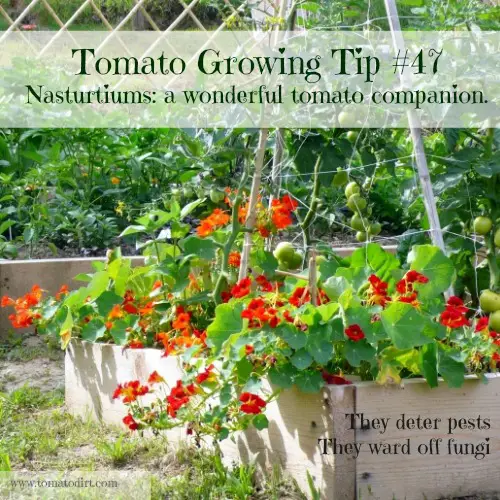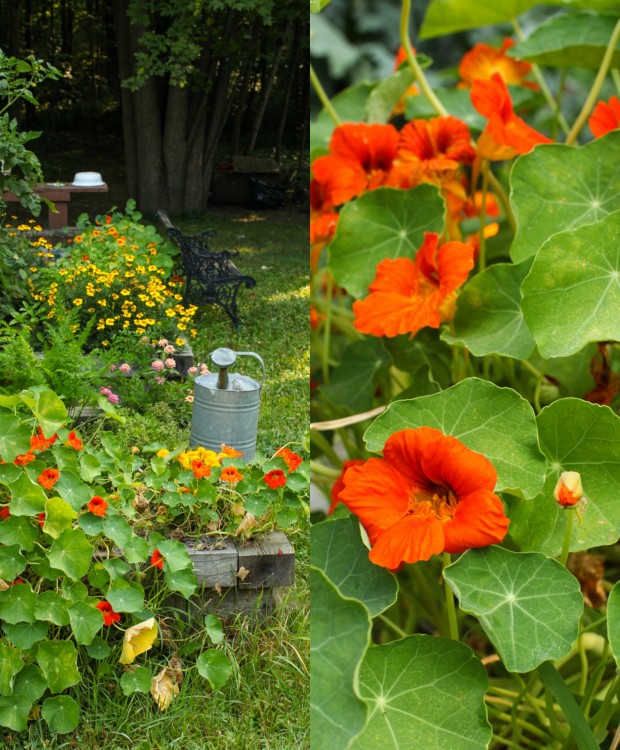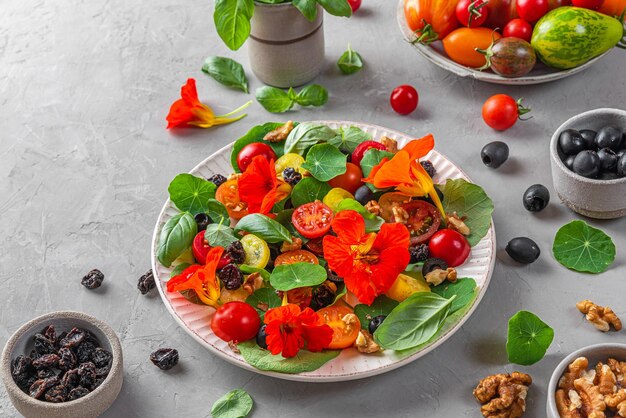The Perfect Pair: Tomatoes And Nasturtiums
The Perfect Pair: Tomatoes and Nasturtiums
Tomatoes and nasturtiums are a classic companion planting combination. They offer a number of benefits to each other, including pest control, improved growth, and better flavor.
Pest Control
One of the biggest benefits of planting tomatoes and nasturtiums together is that they can help to deter pests. Nasturtiums are a natural insect repellent, and they can attract pests away from tomatoes. This is because nasturtiums produce a mustard oil compound that pests find unpleasant.
Specifically, nasturtiums are known to attract aphids, whiteflies, and spider mites. These pests can be a major problem for tomatoes, but they are less likely to bother plants that are growing near nasturtiums.
In addition to attracting pests away from tomatoes, nasturtiums can also help to attract beneficial insects. Beneficial insects, such as ladybugs and lacewings, prey on pests, so they can help to keep your garden pest-free.
Improved Growth
In addition to pest control, planting tomatoes and nasturtiums together can also help to improve the growth of both plants. Nasturtiums can help to improve the drainage of soil, which can be beneficial for tomatoes. They can also help to suppress weeds, which can compete with tomatoes for water and nutrients.
Better Flavor
Finally, tomatoes and nasturtiums can also help to improve the flavor of each other. The mustard oil compound in nasturtiums can enhance the flavor of tomatoes, and the flowers of nasturtiums can add a peppery kick to salads.
How to Plant Tomatoes and Nasturtiums Together
To plant tomatoes and nasturtiums together, you will need to choose a spot in your garden that gets full sun. Both plants prefer well-drained soil, so make sure to amend your soil with compost or other organic matter before planting.
Space your tomato plants about 2 feet apart, and space your nasturtium plants about 1 foot apart. You can plant the nasturtiums between the tomato plants, or you can plant them in a separate bed nearby.
Water your tomato and nasturtium plants regularly, and fertilize them every few weeks with a balanced fertilizer.
Conclusion
Tomatoes and nasturtiums are a perfect pair for companion planting. They offer a number of benefits to each other, including pest control, improved growth, and better flavor. If you are looking for a way to improve your tomato harvest, consider planting nasturtiums nearby.
Tomatoes and nasturtiums are two of the most popular garden plants, and for good reason. They're both beautiful, delicious, and easy to grow. But did you know that they're also great companion plants? That's right, planting tomatoes and nasturtiums together can actually benefit both plants.
Nasturtiums are a natural aphid repellent, so they can help to keep your tomato plants pest-free. They also attract pollinators, which can help to improve the pollination of your tomatoes and lead to a better harvest.
In addition, nasturtiums can help to improve the soil quality around your tomato plants. Their roots release nitrogen into the soil, which can help to fertilize your tomatoes and promote their growth.
So if you're looking for a way to improve the health and productivity of your tomato plants, consider planting some nasturtiums alongside them. You won't be disappointed.
For more information about tomatoes and nasturtiums, please visit Gardenia Inspiration.
FAQ of tomatoes and nasturtiums
1. Do tomatoes and nasturtiums attract the same pests?
No, tomatoes and nasturtiums attract different pests. Tomatoes are susceptible to pests such as aphids, whiteflies, and hornworms. Nasturtiums, on the other hand, are known to repel pests such as aphids, beetles, and slugs. This makes them good companion plants for tomatoes, as they can help to protect them from pests.
2. Can I plant tomatoes and nasturtiums together?
Yes, tomatoes and nasturtiums can be planted together. In fact, they are considered to be good companion plants. When planted together, they can help to improve each other's growth and productivity. For example, nasturtiums can help to attract beneficial insects that can help to control pests on tomatoes.
3. What are the benefits of planting tomatoes and nasturtiums together?
There are several benefits to planting tomatoes and nasturtiums together. These include:
- Improved pest control: As mentioned above, nasturtiums can help to attract beneficial insects that can help to control pests on tomatoes.
- Increased pollination: The bright flowers of nasturtiums can attract pollinators, such as bees and butterflies, which can help to increase pollination of tomatoes.
- Improved soil quality: The roots of nasturtiums can help to improve the soil quality around tomatoes, making it more nutrient-rich and well-drained.
4. How far apart should I plant tomatoes and nasturtiums?
Tomatoes and nasturtiums should be planted about 12-18 inches apart. This will give them enough space to grow and thrive.
5. What are some tips for growing tomatoes and nasturtiums together?
Here are some tips for growing tomatoes and nasturtiums together:
- Plant them in full sun.
- Water them regularly, but don't overwater them.
- Fertilize them monthly with a balanced fertilizer.
- Control pests and diseases.
Image of tomatoes and nasturtiums
- Image 1: A pot of tomatoes and nasturtiums growing in a sunny garden. The tomatoes are red and yellow, and the nasturtiums are orange, yellow, and red.

- Image 2: A row of tomatoes and nasturtiums growing in a vegetable garden. The tomatoes are green and red, and the nasturtiums are orange and yellow.

- Image 3: A close-up of a tomato and a nasturtium flower. The tomato is red, and the nasturtium flower is orange with black spots.

- Image 4: A plate of tomatoes and nasturtiums, ready to be eaten. The tomatoes are sliced, and the nasturtium flowers are used as garnish.

- Image 5: A bouquet of tomatoes and nasturtiums. The tomatoes are red and yellow, and the nasturtiums are orange, yellow, and red.

Post a Comment for "The Perfect Pair: Tomatoes And Nasturtiums"